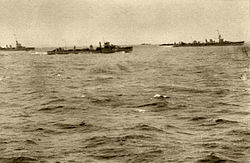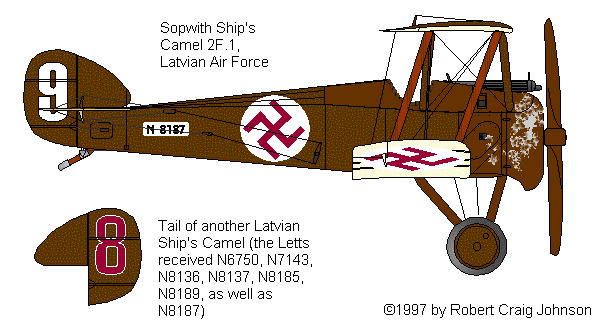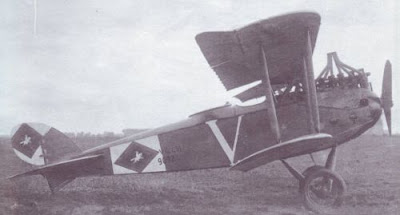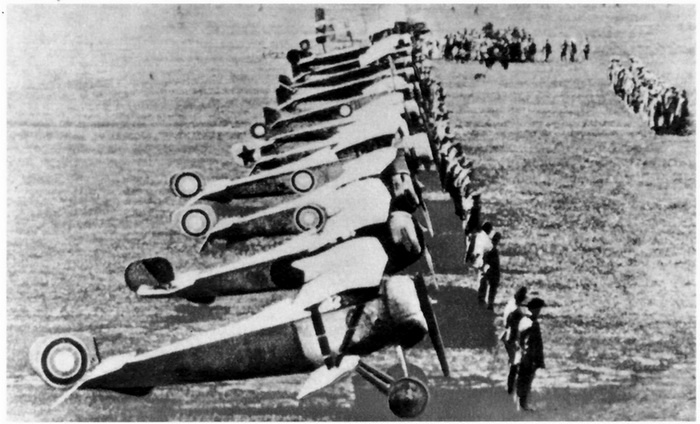Launched in the wake of the Russian collapse and revolution of 1917, the purposes of Operation Red Trek were to stop the rise of Bolshevism, to protect Britain's interests, and to extend the freedom of the seas.
The situation in the Baltic states in the aftermath of World War I was chaotic. The Russian Empire had collapsed and Bolshevik Red Army, pro-independence, and pro-German forces were fighting across the region. Riga had been occupied by the German army in 1917 and German Freikorps and Baltic-German Landeswehr units were still active in the area. Estonia had established a national army with the support of Finnish volunteers and were defending against the 7th Red Army's attack
The Russian Baltic Fleet was the key naval force available to the Bolsheviks and essential to the protection of Petrograd. The fleet was severely depleted after the First World War and Russian revolution but still formed a significant force. At least one Gangut-class battleship, as well as several pre-dreadnought battleships, cruisers, destroyers and submarines were available. Many of the officer corps were on the White Russian side in the Civil War or had been murdered, but some competent leaders remained.
A Royal Navy squadron was sent under Rear-Admiral Edwyn Alexander-Sinclair.
This force consisted of modern C-class cruisers and V- and W-class destroyers. In December 1918, Sinclair sallied into Estonian and Latvian ports, sending in troops and supplies, and promising to attack the Bolsheviks "as far as my guns can reach". In January 1919, he was succeeded in command by Rear-Admiral Walter Cowan.
Sopwith Camel
British GrainGriffin3
British Short 184
Friedrichshafen 33
D.F.W C.V / Latvian Halberstadt
Finnish Friedrichshafen FF 49
British forces denied the Bolsheviks the ability to move by sea, Royal Navy ships bombarded the Bolsheviks on land in support of Estonian and Latvian troops, and provided supplies.
On the night of 4 December, the cruiser HMS Cassandra struck a German-laid mine while on patrol duties north of Liepāja, and sank with the loss of 11 of her crew.
On 26 December, British warships captured the Bolshevik destroyers Avtroil and Spartak, which at the time were shelling the port of Tallinn. Both units were presented to the Estonian Provisional Government and, as Lennuk and Vambola, formed the nucleus of the Estonian Navy. Forty Bolshevik prisoners of war were executed by the Estonian government on Naissaar in February 1919 despite British protests.
The new Commissar of the Baltic Fleet - Fedor Raskolnikov - was captured onboard Spartak. He was exchanged on 27 May 1919 for 17 British officers captured by the Soviets and later appointed Commissar of the Caspian Flotilla by Trotsky. In the Baltic, Raskolnikov was replaced by Nikolai Kuzmin.
-------------
| Baltic Naval War | |||||||||
|---|---|---|---|---|---|---|---|---|---|
| Part of Russian Civil War, Estonian War of Independence, Latvian War of Independence | |||||||||
 British squadron in Koporye Bay in October 1919 | |||||||||
| |||||||||
| Belligerents | |||||||||
| Commanders and leaders | |||||||||
| Casualties and losses | |||||||||
Casualties and losses
British
Light cruiser HMS Cassandra – mined
V-class destroyers:
HMS Verulam – mined
HMS Vittoria – torpedoed by Bolshevik submarine Pantera
Submarine HMS L55 – surface action against Bolshevik destroyers
Arabis-class sloop: HMS Gentian and Myrtle – mined
Coastal Motor Boats: CMB-24, CMB-62 and CMB-79 – surface action against Bolshevik Fleet
CMB-67 – stranded
The 112 deaths of British servicemen—107 RN personnel and five RAF personnel from HMS Vindictive —are commemorated on a memorial plaque, which was unveiled in 2005 at Portsmouth Cathedral in England, with similar memorials in the Church of the Holy Ghost, Tallinn and in St Saviour's Church, Riga.
HMS Cassandra

Hms Verulam
Estonian
Icebreaker tug Hector – struck a rock
Coastal patrol boat Gorodenko – beached by storm

Soviet Cruiser Oleg – torpedoed by CMBs

Depot ship Pamiat Azova – torpedoed by CMBs
Destroyers Spartak and Avtroil – captured by the Royal Navy
Destroyers Gavril, Konstantin and Svoboda – mined
Trawler Kitoboi – defected to White movement
Ships of the Peipus flotilla – captured by Estonia
No figures for Soviet casualties are available.
---------------------------
 A plane ditched alongside HMS Vindictive after returning from air raid, Baltic Sea, 1919 >>>>>
A plane ditched alongside HMS Vindictive after returning from air raid, Baltic Sea, 1919 >>>>>In April 1919, Latvian President Kārlis Ulmanis was forced to seek refuge on board the Saratov under the protection of British ships.
In the summer of 1919, the Royal Navy bottled up the Red fleet in Kronstadt. Several sharp skirmishes were fought near Kotlin Island. In the course of one of these clashes, on 31 May, during a Bolshevik probing action to the west, the battleship Petropavlovsk scored two hits on the destroyer HMS Walker from a distance of 14,000 yards (12,800 m), when a flotilla of British destroyers attempted to catch the outgunned Bolshevik destroyer Azard. Walker, which acted as a lure, suffered some damage and two of her crew were wounded, while the other British destroyers eventually disengaged when they came too close to Bolshevik coastal artillery and minefields.
Admiral Cowan soon realised that Tallinn was not an ideal base of operations and sought a base closer to Kronstadt. On 5 June Cowan and his naval units arrived at the new anchorage at Björkö Sound, which proved ideal for actions against Kronstadt. However, on 9 June the Red fleet's destroyers Gavril and Azard raided the location, and the Royal Navy submarine HMS L55 was sunk with all hands in the aftermath, apparently after being cornered in a British minefield by the Soviet warships. The action prompted the British to lay obstacles and minefields to protect the anchorage. Cowan also requested that Finland allocate a squadron of ships to provide additional protection for the anchorage as well as to take part in the security and patrol duties in the area. The Finnish Navy complied and sent several gun and torpedo boats as well as motor minesweepers to Björkö.

Estonian DUK 17 (russian made - nieuport 17)

Estonian Friedrichshafen FF 41 AT



Lithuania airforce
A flotilla of British Coastal Motor Boats under the command of Lieutenant Augustus Agar raided Kronstadt Harbour twice, sinking the cruiser Oleg and the depot ship Pamiat Azova on 17 June as well as damaging the battleships Petropavlovsk and Andrei Pervozvanny in August, at the cost of three CMBs in the last attack. The British claim that the motor boats damaged the Petropavlosk is dismissed by Soviet records. The first raid was intended to support a significant mutiny at the Krasnaya Gorka fort which was eventually suppressed by the 12 in (300 mm) guns of the Bolshevik battleships. In early July the British received reinforcements which included the aircraft carrier HMS Vindictive whose aircraft carried out bombing and strafing runs against gun and searchlight installations at Kronstadt.

Fore turret of the battleship Petropavlovsk (1925)
In the autumn of 1919, British forces - including the monitor HMS Erebus - provided gunfire support to General Nikolai Yudenich's White Russian Northwestern army in its offensive against Petrograd. The Russians tried to disrupt these bombardments by laying mines using the Orfey-class destroyers, Azard, Gavril, Konstantin, and Svoboda. The latter three ships were sunk in a British minefield on 21 October 1919, during an attempt to defect to Estonia. The White army's offensive failed to capture Petrograd and on 2 February 1920, the Republic of Estonia and Bolshevist Russia signed the Peace Treaty of Tartu which recognised Estonian independence. This resulted in the withdrawal of the Royal Navy from the Baltic.

Frunze

Cavril

Avtroil

Torbedo boat nr 61
The prolonged British presence at Björkö Sound and Cowan's demands to the Finnish government that the small Finnish squadron patrolling the area stay until the British withdrawal from the sound in December 1919 cost the Finnish Navy three torpedo boats which sank when ice crushed their weak hulls. The loss of the three vessels meant that the newly independent Finland's small navy lost 20% of its heavier ships in a single stroke.

Anatra DS

AoDuks Nieuport 11 and 21


Significant unrest took place among British sailors in the Baltic. This included small-scale mutinies amongst the crews of HMS Vindictive, Delhi - the latter due in part to the behaviour of Admiral Cowan - and other ships stationed in Björkö Sound. The causes were a general war-weariness (many of the crews had fought in World War I), poor food and accommodation, a lack of leave, and the effects of Bolshevik propaganda.







Your photos of HMS Cassandra and HMS Verulam are of the wrong ships.
VastaaPoistaHi. Thank you for your correction.
PoistaI need to download new images.
The title says these names
Corrected
PoistaThey were too fresh
HMS Verulam still incorrect. Should be HMS Verulam (1917),
VastaaPoistanot HMS Verulam (R28). Love your blog by the way, you cover subject matter rarely seen in British histories.
Moi = Hi
PoistaLet's try again.
There are only two pictures, the previous and this
both given the same name in 1917 and second in 1919
You say, I rarely published in British events in the war
PoistaThis is true!
The whys and wherefores
Britannia is very much present in many other publications
and very favorite and many know wery well many battles
also United States battles are same.
My original idea, but the situation take along, when I told Finnish wars
PoistaFirst: armor weapon development
Second: I just wanted to bring out a variety of battle tanks and modern tank and massive developer production, who is Soviet Union
And all orders in Stalin, who understand (first)
how importance of the first massive use of tanks
However, Stalin purpose and idea are spreading throughout europe socialism
using soviet tanks and soldiers (over 12.000 tank in 1936)
Love biplanes, great pics!
VastaaPoistaHi, Phil.
PoistaKiitos (thanks) :)
Biplanes are real interestings, also my minds too
At that time, the world was still free
Pilot (driver) dominated by the machine,
(Not as today because machine will manage a man, only motorcycle driving are still free)
British GreenGriffin and Short 184 are all new to me,
I never before heard these planes